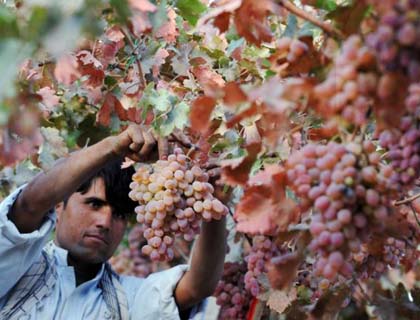Afghanistan's economy is dependent on agriculture. For this reason, agriculture empowerment has been promoted as the main means of economic recovery and growth. Enabling the country's farmers would mean helping a sizeable portion of the society who can create jobs, keep the country's unique natural standing and provide abundant bread to the entire population.
Scientific calculations carried out in 2003, shows that Afghanistan has a total area of 652,221 sq.km. The total area of land in Afghanistan is estimated to be about 650,223,000 hectares out of which 33,610,000 hectares of land is comprised of forests, orchards, and rangelands. The area of arable and horticulture land is estimated about 7,900,000 hectares out of which 3,340,000 hectares of land or less than half of it is cultivated by traditional methods or are partially mechanized and poppy is grown in most parts of it. It is estimated that the cultivation area of poppy is almost the same size of all horticulture areas of the country.
Out of all cultivated land in Afghanistan, 2,200,000 hectares of land is irrigated and 1,140,000 hectares of land is rain-fed. The total area of rangeland which can partially be converted to arable land is about 30,000,000 hectares. The total area of forests is estimated about 1,700,000 hectares which is 200,000 hectares less than year 1357 (1978). It means that Afghanistan has lost around 200,000 hectares of its forests during last thirty years. If appropriate protection measures are not put in place, the devastative process of forests loss will continue and Afghanistan will be exposed to a catastrophic environmental crisis by losing forests and consequently the green areas.
The agriculture land is mainly used for temporary plants like wheat, food, oily and industrial plants. The total land allocated for this purpose reaches to 322,400 hectares. The land allocated for permanent plants which include horticultures and other vegetation include 146,000 hectares.
The agriculture sector has numerous potentials for employment creation, promoting production and processing. Currently, only half of the arable agriculture land is in use, in general, the cultivation is conducted through traditional methods which significantly decrease the products. In average, the outcome is estimated less than two tones in each hectares land. The Ministry of Agriculture and Livestock announced that this year the agriculture products reach to 6,333,000 tons which shows a remarkable increase than previous years due to sound environment and abundant rainfalls. In average, the agriculture products are predicted less than 200,000 tons per year.
In addition to pomegranate, pin nut, pistachio and self-grown almond can also have power to compete in global market. Another Afghan fruit which has special quality is mulberry. This fruit with its useful and curative qualities after being introduced to global market through publicizing can be one of the competitive export products of Afghanistan. From equatorial parts to temperate parts of Afghanistan different kinds of fruits with best quality are growing, grapes, pear, apple, cherry, black cherry, fig, apricot, almond, sweet apricot, melon, water melon, red and green raisons, pistachio, nuts, walnut, mulberry and pomegranate are the fruits which are counted the delicious and famous fruits of Afghanistan.
These fruits with a little attention can soak the national markets and be exported to international markets. All steps of processing and packaging should comply with globally accepted standards and it should be carried out inside Afghanistan and should be directly exported to world supermarkets as ready and consumable product. In this way not only the products will be sold on original price but also the added value which used to be more than the original price of product will remain inside the country.
One of the other important exporting items of Afghanistan is medicinal plants that can be used in pharmaceutics industries, cosmetics and kitchen instruments production. There are fifty-seven medicinal plants which are being exported from Afghanistan and the most important ones are cumin, licorice and saffron. There is a very high demand for aforementioned plants in global market. All these plants are natural and self-gown plants except saffron which is now being planted in fields.
But as other plants have changed to domestic plants by human and have been supplied to markets based on demands, with research and investigation and finding the adoption of these plants grown in Afghanistan with best quality, can be increased for production.
By increasing and promoting these useful and beneficial plants with medicinal properties can be produced based on international market demands. Land and man power, as important factors of production are sufficiently available in Afghanistan. If policy and manual for supporting and encouraging the employment program is established, production and processing of medicinal plants exports which has competitive power market in international market and because of high quality can be increased and it can be carried to account as an important element in job creation, progress in national per capita income and increasing exports or at least accomplish the preliminary processing and packaging in Afghanistan which are currently being accomplished in Pakistan and India and avoid the escape of value added.
The process of medicinal plants production till exports can be a part of job creation, extending trade balance and increase the exports income. In this section, the improvement of situation depends upon better measures of private sector, government and international community. Twenty thousand jobs in sections of production expansion, processing, juicing, packaging, exports, reproducing, marketing, agricultural and export management and industrial management can be created in a very short period of time.
Afghanistan's agriculture needs attention and technological renovation. It is a time-consuming but necessary process to machenarize the agriculture and provides farmers with both necessary skills and equipment to both maintain and improve this important sector.

